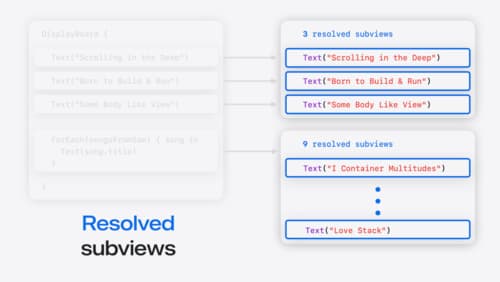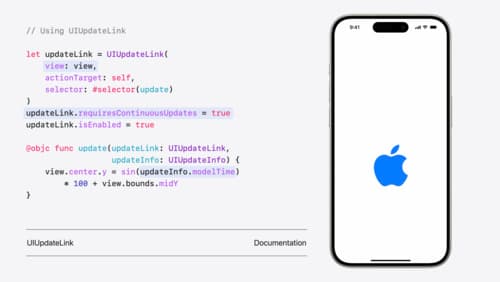how to use uicollectionview
Asked on 2024-07-31
1 search
To use UICollectionView in your iOS app, you can refer to the session "What’s new in UIKit" from WWDC 2024. This session covers various improvements and new features in UIKit, including updates to UICollectionView.
Key Points on Using UICollectionView:
-
List Environment Trait:
UICollectionViewlist sections andUITableViewnow have the list environment trait set. This trait helps ensure that cells are styled appropriately in any given list.UIListContentConfigurationandUIBackgroundConfigurationtake advantage of this new trait, adjusting their properties to match the list environment from the configuration state's trait collection.- This removes the need to know the style of the list when configuring a cell. Instead, the cell configuration code only needs to know the style required by the content (e.g., regular cell, header, or footer).
-
Compositional Layout:
- The session provides an example of using
UICollectionViewwith a compositional layout to display a list of locations, favorites, and tags in different styles depending on the context (e.g., inset grouped appearance in portrait mode).
- The session provides an example of using
-
Automatic Appearance Updates:
- New header and footer configurations automatically update their appearance from the list environment trait.
UIBackgroundConfigurationhas new constructors for list cell, list header, and list footer, which also update appearance automatically.
-
UIUpdateLink:
- Introduced in iOS 18,
UIUpdateLinkmakes it easier to implement complex animations that require periodic UI updates. It is similar toCADisplayLinkbut with more features, such as automatic view tracking and low latency mode for drawing applications.
- Introduced in iOS 18,
For more detailed information, you can watch the session What’s new in UIKit starting at the "List improvements" chapter.
Relevant Sessions:
These sessions will provide you with a comprehensive understanding of the latest updates and best practices for using UICollectionView in your iOS applications.

Demystify SwiftUI containers
Learn about the capabilities of SwiftUI container views and build a mental model for how subviews are managed by their containers. Leverage new APIs to build your own custom containers, create modifiers to customize container content, and give your containers that extra polish that helps your apps stand out.

Migrate your TVML app to SwiftUI
SwiftUI helps you build great apps on all Apple platforms and is the preferred toolkit for bringing your content into the living room with tvOS 18. Learn how to use SwiftUI to create familiar layouts and controls from TVMLKit, and get tips and best practices.

What’s new in UIKit
Explore everything new in UIKit, including tab and document launch experiences, transitions, and text and input changes. We’ll also discuss better-than-ever interoperability between UIKit and SwiftUI animations and gestures, as well as general improvements throughout UIKit.
